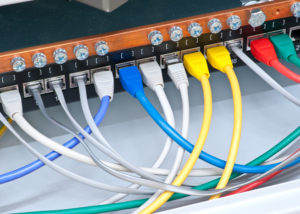
Campus technology departments across the country are finding that investing in energy-efficient technologies has an economic benefit as well as helping to save the environment.
“We projected a 30-percent increase in power efficiency … and [are] looking at about $7,700 in annual savings,” said Daniel Lichter, director of data and network infrastructure at Saint Xavier University. Much of these savings have come from consolidating servers, Lichter said.
CDW Government LLC (CDW-G) surveyed 756 technology professionals for its 2010 “Energy Efficient IT Report” and found that three-quarters of respondents are working to reduce energy use in their IT operations. If current energy use rates don’t change, greenhouse gas emissions from data centers will outweigh those from the airline industry by 2020, the company warns.
“The power usage in the data center is ever increasing, especially with rising energy costs,” said Mark Lafferty, director of strategic solutions and services for CDW-G. “That seems to be the most popular place to review your energy strategies.”
The popularity of the environmental movement, combined with the potential to save on energy costs, inspired Lichter to change Xavier’s campus technology department.
He said the heat generated by servers had been a major energy consumer on campus.
“We did a server virtualization and consolidation initiative to reduce the number of servers that were consuming electricity and generating heat,” Lichter said. “We [also] completed the replacement of a 25-year-old air conditioning unit in the server room with a much more efficient and much more appropriate intercooling unit.”
“There’s been a lot of over-capacity for a long time,” added Lafferty. “I think with the onset of virtualization, you’re getting more efficiency through fewer servers. With the consolidation there, you gain the benefit of not needing to cool and to power as many servers.”
Lafferty encouraged other colleges and universities to map out their own campus technology department’s energy use.
“Utilize some of the tools that are available, either from the EPA or the Department of Energy, to really get a take on what you have and what your energy consumption looks like,” he said. “[Then] build a strategy to address those needs.”
CDW-G suggested the following strategies to cut back on energy use in campus technology departments:
• Deploying more power-efficient core switches;
• Replacing edge and workgroup switches with more power-efficient switches;
• Using the network as a platform to manage and reduce energy use;
• Adopting 10GB Ethernet, Infiniband technologies;
• Reducing storage area network infrastructure by implementing Fiber-channel Over Ethernet (FcOE); and
• Moving to top-of-rack models for access layer switching.
CDW-G found that of those organizations already actively trying to manage their energy use, 56 percent have reduced their annual annual IT energy costs by at least 1 percent.
Data centers currently account for 1.5 percent of the total U.S. energy consumption, which accounts for $4.5 billion a year, according to federal figures. The Environmental Protection Agency has predicted that that amount will nearly double within the next five years.
- Which eReader is right for you? - March 23, 2011
- Feds settle case of woman fired over Facebook site - February 9, 2011
- Virtual classrooms take over LSAT prep - January 28, 2011

